Yanhua Cheng
VQL: An End-to-End Context-Aware Vector Quantization Attention for Ultra-Long User Behavior Modeling
Aug 23, 2025Abstract:In large-scale recommender systems, ultra-long user behavior sequences encode rich signals of evolving interests. Extending sequence length generally improves accuracy, but directly modeling such sequences in production is infeasible due to latency and memory constraints. Existing solutions fall into two categories: (1) top-k retrieval, which truncates the sequence and may discard most attention mass when L >> k; and (2) encoder-based compression, which preserves coverage but often over-compresses and fails to incorporate key context such as temporal gaps or target-aware signals. Neither class achieves a good balance of low-loss compression, context awareness, and efficiency. We propose VQL, a context-aware Vector Quantization Attention framework for ultra-long behavior modeling, with three innovations. (1) Key-only quantization: only attention keys are quantized, while values remain intact; we prove that softmax normalization yields an error bound independent of sequence length, and a codebook loss directly supervises quantization quality. This also enables L-free inference via offline caches. (2) Multi-scale quantization: attention heads are partitioned into groups, each with its own small codebook, which reduces quantization error while keeping cache size fixed. (3) Efficient context injection: static features (e.g., item category, modality) are directly integrated, and relative position is modeled via a separable temporal kernel. All context is injected without enlarging the codebook, so cached representations remain query-independent. Experiments on three large-scale datasets (KuaiRand-1K, KuaiRec, TMALL) show that VQL consistently outperforms strong baselines, achieving higher accuracy while reducing inference latency, establishing a new state of the art in balancing accuracy and efficiency for ultra-long sequence recommendation.
CHIME: A Compressive Framework for Holistic Interest Modeling
Apr 09, 2025Abstract:Modeling holistic user interests is important for improving recommendation systems but is challenged by high computational cost and difficulty in handling diverse information with full behavior context. Existing search-based methods might lose critical signals during behavior selection. To overcome these limitations, we propose CHIME: A Compressive Framework for Holistic Interest Modeling. It uses adapted large language models to encode complete user behaviors with heterogeneous inputs. We introduce multi-granular contrastive learning objectives to capture both persistent and transient interest patterns and apply residual vector quantization to generate compact embeddings. CHIME demonstrates superior ranking performance across diverse datasets, establishing a robust solution for scalable holistic interest modeling in recommendation systems.
BBQRec: Behavior-Bind Quantization for Multi-Modal Sequential Recommendation
Apr 09, 2025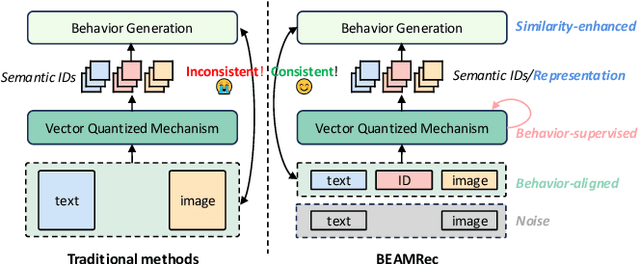
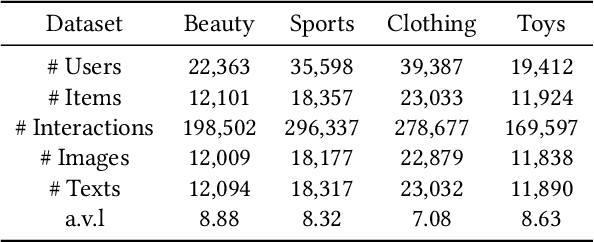
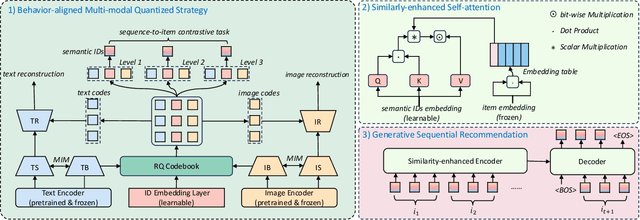
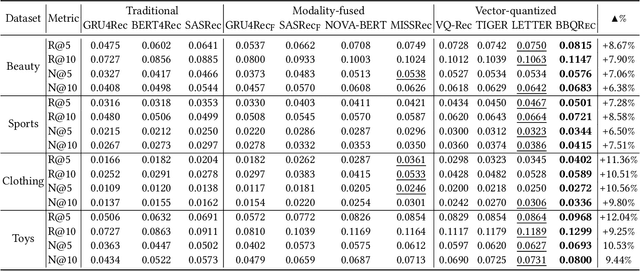
Abstract:Multi-modal sequential recommendation systems leverage auxiliary signals (e.g., text, images) to alleviate data sparsity in user-item interactions. While recent methods exploit large language models to encode modalities into discrete semantic IDs for autoregressive prediction, we identify two critical limitations: (1) Existing approaches adopt fragmented quantization, where modalities are independently mapped to semantic spaces misaligned with behavioral objectives, and (2) Over-reliance on semantic IDs disrupts inter-modal semantic coherence, thereby weakening the expressive power of multi-modal representations for modeling diverse user preferences. To address these challenges, we propose a Behavior-Bind multi-modal Quantization for Sequential Recommendation (BBQRec for short) featuring dual-aligned quantization and semantics-aware sequence modeling. First, our behavior-semantic alignment module disentangles modality-agnostic behavioral patterns from noisy modality-specific features through contrastive codebook learning, ensuring semantic IDs are inherently tied to recommendation tasks. Second, we design a discretized similarity reweighting mechanism that dynamically adjusts self-attention scores using quantized semantic relationships, preserving multi-modal synergies while avoiding invasive modifications to the sequence modeling architecture. Extensive evaluations across four real-world benchmarks demonstrate BBQRec's superiority over the state-of-the-art baselines.
S-Diff: An Anisotropic Diffusion Model for Collaborative Filtering in Spectral Domain
Dec 31, 2024



Abstract:Recovering user preferences from user-item interaction matrices is a key challenge in recommender systems. While diffusion models can sample and reconstruct preferences from latent distributions, they often fail to capture similar users' collective preferences effectively. Additionally, latent variables degrade into pure Gaussian noise during the forward process, lowering the signal-to-noise ratio, which in turn degrades performance. To address this, we propose S-Diff, inspired by graph-based collaborative filtering, better to utilize low-frequency components in the graph spectral domain. S-Diff maps user interaction vectors into the spectral domain and parameterizes diffusion noise to align with graph frequency. This anisotropic diffusion retains significant low-frequency components, preserving a high signal-to-noise ratio. S-Diff further employs a conditional denoising network to encode user interactions, recovering true preferences from noisy data. This method achieves strong results across multiple datasets.
Enhancing Instruction-Following Capability of Visual-Language Models by Reducing Image Redundancy
Nov 23, 2024


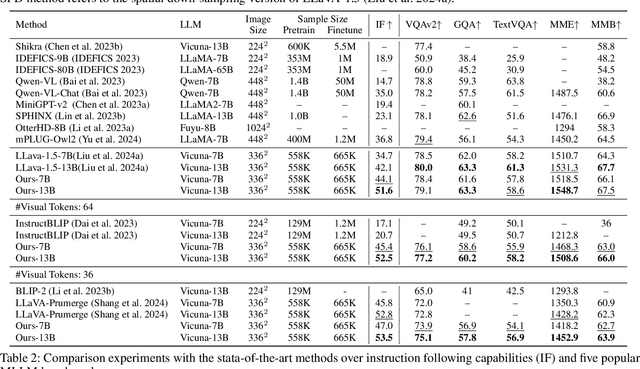
Abstract:Large Language Models (LLMs) have strong instruction-following capability to interpret and execute tasks as directed by human commands. Multimodal Large Language Models (MLLMs) have inferior instruction-following ability compared to LLMs. However, there is a significant gap in the instruction-following capabilities between the MLLMs and LLMs. In this study, we conduct a pilot experiment, which demonstrates that spatially down-sampling visual tokens significantly enhances the instruction-following capability of MLLMs. This is attributed to the substantial redundancy in visual modality. However, this intuitive method severely impairs the MLLM's multimodal understanding capability. In this paper, we propose Visual-Modality Token Compression (VMTC) and Cross-Modality Attention Inhibition (CMAI) strategies to alleviate this gap between MLLMs and LLMs by inhibiting the influence of irrelevant visual tokens during content generation, increasing the instruction-following ability of the MLLMs while retaining their multimodal understanding capacity. In VMTC module, the primary tokens are retained and the redundant tokens are condensed by token clustering and merging. In CMAI process, we aggregate text-to-image attentions by text-to-text attentions to obtain a text-to-image focus score. Attention inhibition is performed on the text-image token pairs with low scores. Our comprehensive experiments over instruction-following capabilities and VQA-V2, GQA, TextVQA, MME and MMBench five benchmarks, demonstrate that proposed strategy significantly enhances the instruction following capability of MLLMs while preserving the ability to understand and process multimodal inputs.
Knowledge Condensation and Reasoning for Knowledge-based VQA
Mar 15, 2024Abstract:Knowledge-based visual question answering (KB-VQA) is a challenging task, which requires the model to leverage external knowledge for comprehending and answering questions grounded in visual content. Recent studies retrieve the knowledge passages from external knowledge bases and then use them to answer questions. However, these retrieved knowledge passages often contain irrelevant or noisy information, which limits the performance of the model. To address the challenge, we propose two synergistic models: Knowledge Condensation model and Knowledge Reasoning model. We condense the retrieved knowledge passages from two perspectives. First, we leverage the multimodal perception and reasoning ability of the visual-language models to distill concise knowledge concepts from retrieved lengthy passages, ensuring relevance to both the visual content and the question. Second, we leverage the text comprehension ability of the large language models to summarize and condense the passages into the knowledge essence which helps answer the question. These two types of condensed knowledge are then seamlessly integrated into our Knowledge Reasoning model, which judiciously navigates through the amalgamated information to arrive at the conclusive answer. Extensive experiments validate the superiority of the proposed method. Compared to previous methods, our method achieves state-of-the-art performance on knowledge-based VQA datasets (65.1% on OK-VQA and 60.1% on A-OKVQA) without resorting to the knowledge produced by GPT-3 (175B).
Towards Efficient and Effective Text-to-Video Retrieval with Coarse-to-Fine Visual Representation Learning
Jan 01, 2024Abstract:In recent years, text-to-video retrieval methods based on CLIP have experienced rapid development. The primary direction of evolution is to exploit the much wider gamut of visual and textual cues to achieve alignment. Concretely, those methods with impressive performance often design a heavy fusion block for sentence (words)-video (frames) interaction, regardless of the prohibitive computation complexity. Nevertheless, these approaches are not optimal in terms of feature utilization and retrieval efficiency. To address this issue, we adopt multi-granularity visual feature learning, ensuring the model's comprehensiveness in capturing visual content features spanning from abstract to detailed levels during the training phase. To better leverage the multi-granularity features, we devise a two-stage retrieval architecture in the retrieval phase. This solution ingeniously balances the coarse and fine granularity of retrieval content. Moreover, it also strikes a harmonious equilibrium between retrieval effectiveness and efficiency. Specifically, in training phase, we design a parameter-free text-gated interaction block (TIB) for fine-grained video representation learning and embed an extra Pearson Constraint to optimize cross-modal representation learning. In retrieval phase, we use coarse-grained video representations for fast recall of top-k candidates, which are then reranked by fine-grained video representations. Extensive experiments on four benchmarks demonstrate the efficiency and effectiveness. Notably, our method achieves comparable performance with the current state-of-the-art methods while being nearly 50 times faster.
Cross-view Semantic Alignment for Livestreaming Product Recognition
Aug 19, 2023



Abstract:Live commerce is the act of selling products online through live streaming. The customer's diverse demands for online products introduce more challenges to Livestreaming Product Recognition. Previous works have primarily focused on fashion clothing data or utilize single-modal input, which does not reflect the real-world scenario where multimodal data from various categories are present. In this paper, we present LPR4M, a large-scale multimodal dataset that covers 34 categories, comprises 3 modalities (image, video, and text), and is 50x larger than the largest publicly available dataset. LPR4M contains diverse videos and noise modality pairs while exhibiting a long-tailed distribution, resembling real-world problems. Moreover, a cRoss-vIew semantiC alignmEnt (RICE) model is proposed to learn discriminative instance features from the image and video views of the products. This is achieved through instance-level contrastive learning and cross-view patch-level feature propagation. A novel Patch Feature Reconstruction loss is proposed to penalize the semantic misalignment between cross-view patches. Extensive experiments demonstrate the effectiveness of RICE and provide insights into the importance of dataset diversity and expressivity. The dataset and code are available at https://github.com/adxcreative/RICE
Cross-Domain Product Representation Learning for Rich-Content E-Commerce
Aug 10, 2023Abstract:The proliferation of short video and live-streaming platforms has revolutionized how consumers engage in online shopping. Instead of browsing product pages, consumers are now turning to rich-content e-commerce, where they can purchase products through dynamic and interactive media like short videos and live streams. This emerging form of online shopping has introduced technical challenges, as products may be presented differently across various media domains. Therefore, a unified product representation is essential for achieving cross-domain product recognition to ensure an optimal user search experience and effective product recommendations. Despite the urgent industrial need for a unified cross-domain product representation, previous studies have predominantly focused only on product pages without taking into account short videos and live streams. To fill the gap in the rich-content e-commerce area, in this paper, we introduce a large-scale cRoss-dOmain Product Ecognition dataset, called ROPE. ROPE covers a wide range of product categories and contains over 180,000 products, corresponding to millions of short videos and live streams. It is the first dataset to cover product pages, short videos, and live streams simultaneously, providing the basis for establishing a unified product representation across different media domains. Furthermore, we propose a Cross-dOmain Product rEpresentation framework, namely COPE, which unifies product representations in different domains through multimodal learning including text and vision. Extensive experiments on downstream tasks demonstrate the effectiveness of COPE in learning a joint feature space for all product domains.
3rd Place Solution to "Google Landmark Retrieval 2020"
Aug 25, 2020
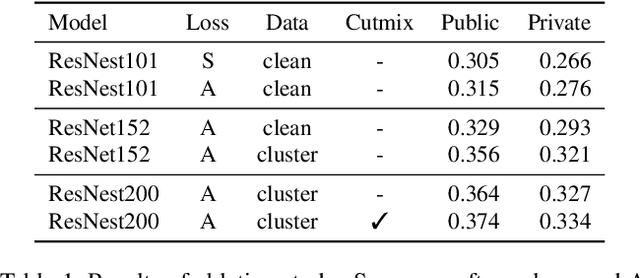


Abstract:Image retrieval is a fundamental problem in computer vision. This paper presents our 3rd place detailed solution to the Google Landmark Retrieval 2020 challenge. We focus on the exploration of data cleaning and models with metric learning. We use a data cleaning strategy based on embedding clustering. Besides, we employ a data augmentation method called Corner-Cutmix, which improves the model's ability to recognize multi-scale and occluded landmark images. We show in detail the ablation experiments and results of our method.
 Add to Chrome
Add to Chrome Add to Firefox
Add to Firefox Add to Edge
Add to Edge